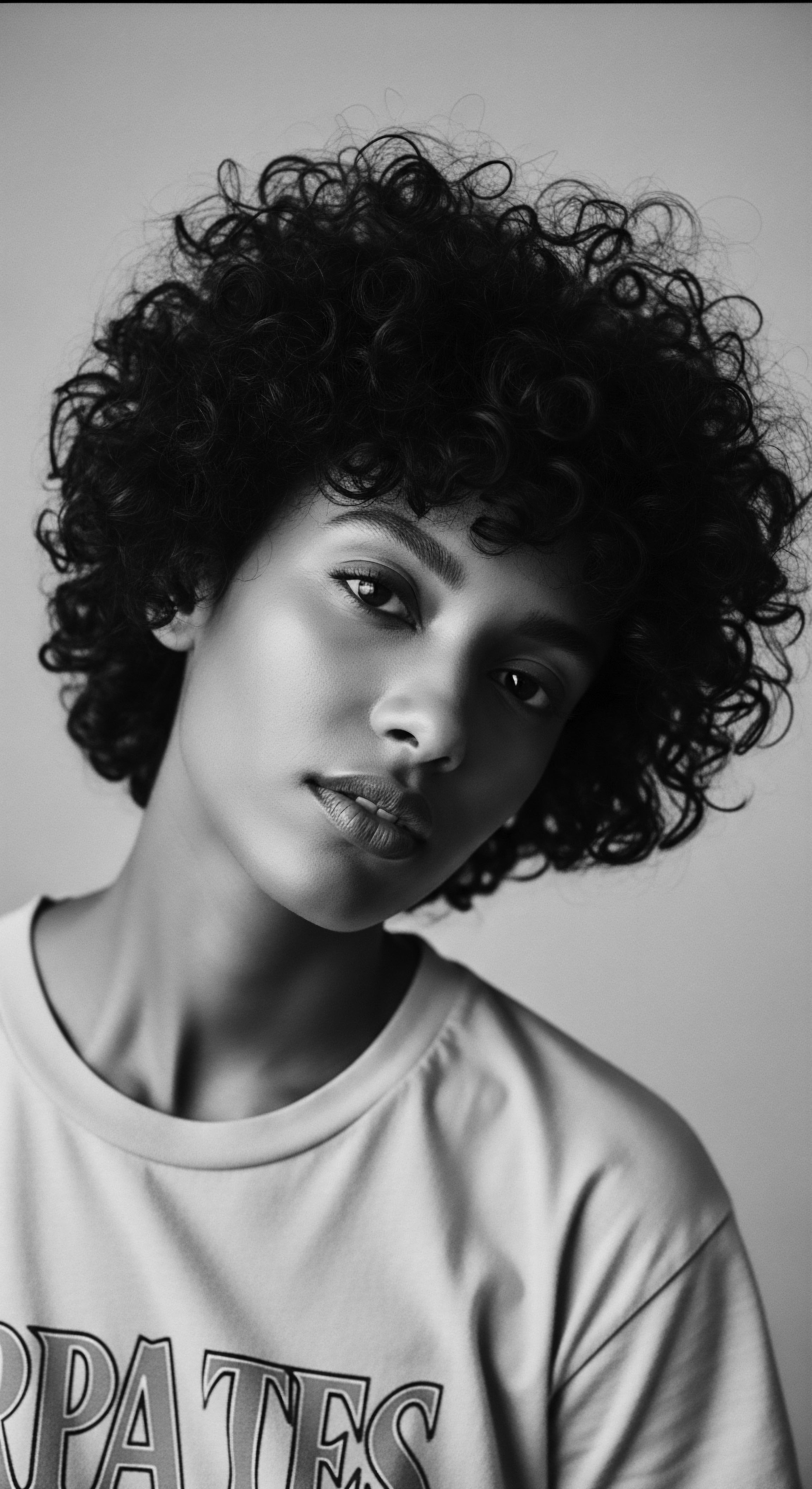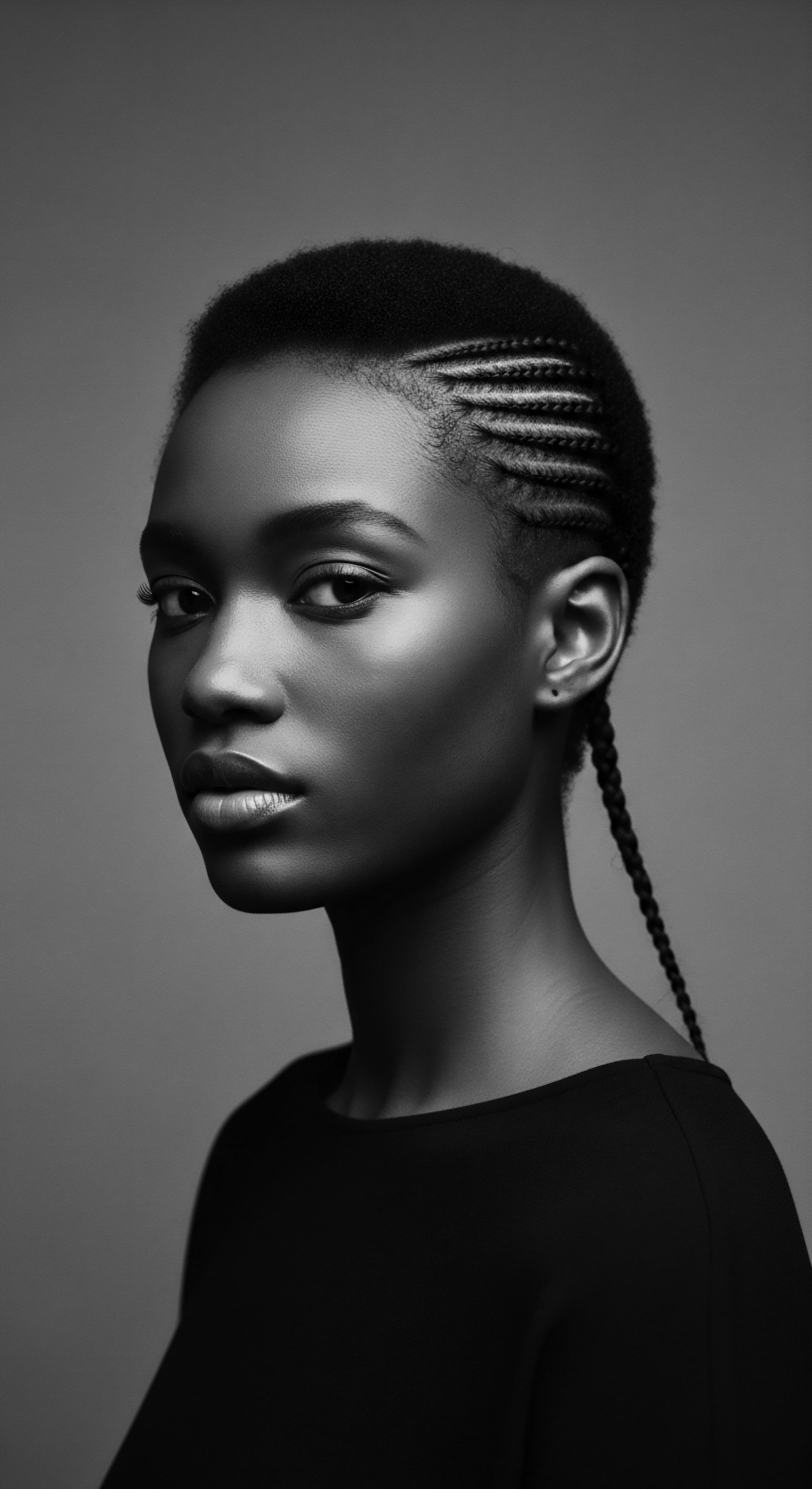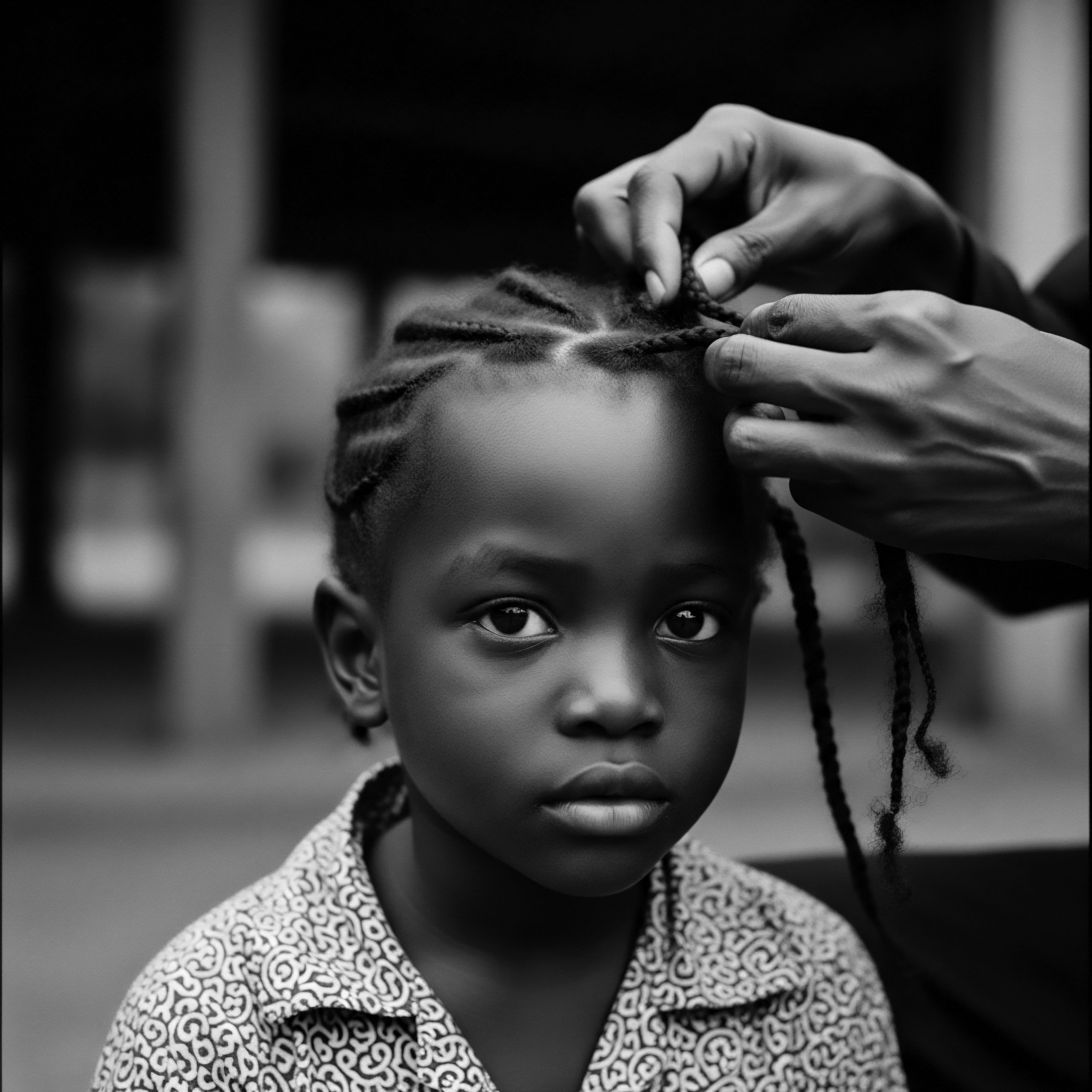
Roots
The very strands that crown us carry echoes of journeys long past, whispers of sunlight filtering through rainforest canopies, and the resilient spirit of ancestral hands. For those whose hair coils and kinks into magnificent constellations, its story is inextricably linked to the earth itself, particularly in the vibrant archipelago of the Caribbean. Here, where land and sea converge in a dance of breathtaking splendor, communities forged a profound bond with their natural surroundings, discerning in the verdant foliage not just sustenance, but also the very remedies for hair care, honoring a heritage passed down through generations.
Consider the intricate geography of a single curl – its elliptical shape, its unique cuticle arrangement, its susceptibility to dryness. These characteristics, often celebrated today, presented specific care needs that ancestral Caribbean communities met with an innate wisdom drawn from their immediate environment. They understood the hair’s thirst, its need for strength, and its yearning for vibrancy, long before modern scientific terminology existed. This understanding wasn’t learned from textbooks; it was observed, experimented with, and transmitted through the quiet repetition of daily ritual.

Ancestral Hair Anatomy and Its Care
The perception of hair’s very structure, through the lens of ancestral wisdom, differed markedly from contemporary microscopic views. For these communities, hair wasn’t just a biological outgrowth; it was a conduit, a protector, and a statement of identity. Its perceived health was tied to its sheen, its strength against breakage, and its ability to hold styles that signified status, marital state, or tribal affiliation.
The plant remedies they sought mirrored these practical and spiritual requirements. They intuitively selected plants that offered natural emollients for softening, mucilage for slip, and astringents for cleansing the scalp, addressing the hair’s need for moisture and structural integrity.
One might look at the aloe vera plant, a ubiquitous sight across many Caribbean islands. Its thick, fleshy leaves house a clear, gelatinous pulp. Ancestral users, without laboratory analysis, observed its capacity to soothe irritated skin and provide a cooling sensation. For hair, this translated to a powerful scalp tonic, believed to alleviate itchiness and promote healthy growth.
Its natural slipperiness also made it an excellent detangler, easing the often arduous process of combing through dense, coiled hair. The very presence of aloe vera in kitchen gardens across the islands speaks to its deep integration into daily wellness and beauty routines.
Ancestral Caribbean communities intuitively selected plants offering natural emollients, mucilage, and astringents, meeting the hair’s need for moisture and structural integrity.
The knowledge of hair’s fundamental needs, then, was not codified in scientific papers, but in the collective memory of hands accustomed to the feel of a healthy coil, the sight of a lustrous braid, and the scent of a freshly prepared herbal rinse. This hands-on understanding formed the bedrock of their hair care practices, laying a profound foundation for what we now understand about textured hair’s unique biological makeup.

Traditional Classifications of Textured Hair and Plant Uses
Formal classification systems for textured hair types, such as those popular today, are relatively modern constructs. Yet, within Caribbean communities, an informal, experience-based categorization existed. Hair might be described by its visual density, its coiling pattern (from loose waves to tight, compact kinks), or its perceived porosity. These descriptors, often woven into oral traditions and communal conversations, guided the selection of specific plant remedies.
- Cerasee (Bitter Melon Vine) ❉ Used as a powerful cleanser and often employed for hair that felt oily or weighed down, or for scalps prone to irritation. Its astringent properties were highly valued.
- Hibiscus (Sorrel) ❉ The petals of the vibrant hibiscus flower, when steeped, yield a mucilaginous liquid. This was often used for its softening properties and to add a reddish tint to dark hair, giving it a natural sheen.
- Moringa ❉ Though more commonly associated with nutrition, the leaves of the moringa tree were sometimes crushed into pastes for their perceived strengthening qualities, aiming to reduce hair breakage.
Consider the island of Jamaica, where the leaves of the castor bean plant, beyond their oil, were sometimes boiled to create a strengthening rinse. This practice speaks to a broader understanding of how different plant parts possessed distinct properties – roots for grounding, leaves for cleansing or soothing, flowers for beauty and softness. The efficacy of these traditional applications, often passed from elder to youth, stood as a testament to the community’s profound connection with the botanical world.

A Lexicon Rooted in the Earth
The language used to describe textured hair and its care within these communities was vibrant, steeped in lived experience, and intrinsically linked to the natural world. Terms might describe the springiness of a curl, the texture of a braid, or the ritual of washing with a specific plant. These words weren’t merely labels; they were mnemonic devices, carrying centuries of knowledge and care practices.
The act of preparing a plant-based hair treatment was often called a ‘bush bath’ or a ‘herbal wash,’ immediately invoking the natural source of the ingredients. The very act of naming solidified the bond between the individual, their hair, and the land that sustained them.
| Traditional Plant Name Black Castor Oil |
| Common Use in Hair Care Strengthening, promoting growth, sealing moisture for thicker hair. |
| Traditional Plant Name Aloe Vera |
| Common Use in Hair Care Soothing scalp, detangling, providing moisture. |
| Traditional Plant Name Rosemary |
| Common Use in Hair Care Stimulating scalp circulation, adding shine, believed to aid growth. |
| Traditional Plant Name Nopal Cactus (Prickly Pear) |
| Common Use in Hair Care Hydrating, conditioning, providing slip for styling. |
| Traditional Plant Name These plants, and many others, formed the foundation of hair vitality within Caribbean heritage. |
The preparation of these plant remedies itself formed a lexicon of activity ❉ grinding, steeping, infusing, pressing. Each action had a purpose, a traditional method that yielded the most beneficial outcome. This meticulous preparation highlights the respect and value placed on the plants and the heritage they represented. It was not a quick fix, but a dedicated act of care, a conversation with nature itself.

Growth Cycles and Environmental Influences
While modern science dissects the anagen, catagen, and telogen phases of hair growth, ancestral Caribbean communities observed the hair’s natural cycles through seasonal changes and the rhythms of life. They understood that hair thrived when the body was well nourished and the environment supported growth.
Historical environmental factors, such as the tropical climate’s humidity and the abundant sunshine, certainly influenced hair health. The diet, rich in fruits, vegetables, and lean proteins derived from the land and sea, provided internal nourishment. Plant-based hair care practices often complemented these internal factors.
For instance, the soursop leaf , sometimes used in rinses, was understood to provide a cleansing action, ensuring a clean scalp environment conducive to healthy growth. These practices underscore a holistic understanding ❉ hair health was seen as an extension of overall bodily wellness, a perspective deeply rooted in ancestral philosophies.

Ritual
The care of textured hair in Caribbean communities transcended mere hygiene; it ascended to the level of ritual, a sacred practice interwoven with identity, community, and the continuity of heritage. Each application of a botanical blend, each careful manipulation of a coil, was a tender thread in a larger story, one that honored the past while shaping the present. These practices were an art, a science, and a social event, often performed collectively, cementing bonds and passing down wisdom.
The choice of plants for these rituals was never arbitrary. It was the culmination of centuries of observation and intergenerational knowledge transfer, a deep attunement to what the land offered. From the softening mucilage of the okra pod, sometimes used in washes and conditioners, to the stimulating properties of rosemary , steeped into potent rinses, every ingredient had a purpose, often multiple purposes, each understood through repeated application and shared results.

Protective Styling From Ancestral Roots
Protective styles, a cornerstone of textured hair care today, find their origins deep within ancestral Caribbean practices. Braids, twists, and locs were not only aesthetic expressions; they were ingenious methods of safeguarding the hair from environmental elements, reducing breakage, and promoting length retention. Natural plants played a significant role in preparing the hair for these styles and maintaining them. Before braiding, hair might be treated with rich plant oils or infusions to enhance elasticity and prevent tension.
Consider the tradition of using coconut oil . This precious commodity, extracted from the fruit of the ubiquitous coconut palm, served as a multi-purpose balm. It was applied generously to strands before braiding, offering a natural lubricant that reduced friction and imparted a lustrous sheen.
Its perceived ability to penetrate the hair shaft, providing internal nourishment, made it a staple in pre-styling rituals. This practice wasn’t just about superficial gloss; it was about laying a protective foundation that allowed the hair to rest and recuperate within the confines of a protective style.
Protective styling in the Caribbean was an ingenious blend of aesthetics and practicality, deeply supported by natural plant applications.

Natural Styling Techniques and Plant Influence
Beyond protective styles, Caribbean communities used plants to define and enhance their hair’s natural texture. Techniques for achieving curl definition, elongation, or volume often incorporated plant-based concoctions, revealing a sophisticated understanding of how botanical compounds interacted with the hair’s structure. These methods were often subtle, relying on the inherent properties of the plants themselves to coax the hair into its desired form.

How Did Plant-Derived Gels Aid Hair Definition?
A particularly inventive method involved the creation of natural gels. The sap of certain plants, like the Nopal cactus (prickly pear) or the boiled leaves of flaxseed , yielded a mucilaginous liquid. When applied to damp hair, these natural gels provided a light hold and definition without the stiffness or residue of modern styling products.
They worked by creating a gentle, flexible cast around the hair strands, allowing the natural curl pattern to dry in a defined shape. This ancestral understanding of natural polymers for hair styling speaks volumes about their ingenuity and observation of the natural world.
Another approach involved using plant-infused waters as setting lotions. After washing, a rinse prepared from certain barks or leaves, believed to have slight adhesive qualities, would be applied. This would then be followed by twisting or braiding the damp hair, allowing it to dry and set into a particular pattern. The results were soft, natural-looking curls or waves, a testament to the subtle power of botanical compounds.

Traditional Tools and Plant Pairings
The tools of Caribbean hair care, though seemingly simple, were perfectly adapted to textured hair and often complemented the plant-based treatments. Wide-toothed combs carved from wood, smooth stones used for applying pressure, or even skilled fingers themselves, were all part of the ritual. The effectiveness of these tools was enhanced by the conditioning and lubricating properties of the plants used.
Imagine the careful use of a wooden comb after a thorough conditioning treatment with a mix of avocado pulp and honey (often gathered locally). The avocado, rich in natural oils, and honey, a humectant, would soften the hair, making it more pliable and less prone to breakage during the detangling process. The wooden comb, unlike modern plastic alternatives, would glide through the hair with less static and snagging, a synergy of natural materials and methods. The ritual of hair care, therefore, was a complete ecosystem of elements working in harmony.

Relay
The transmission of knowledge concerning hair care in Caribbean communities represents a powerful relay of wisdom, a continuous stream flowing from one generation to the next, often through the intimate act of hair dressing itself. This exchange wasn’t merely about techniques; it was about passing down a philosophy of holistic well-being, an ancestral understanding that external vitality mirrored internal balance. The use of natural plants for textured hair, therefore, stands as a vibrant testament to this enduring heritage, a living library of practices that continue to shape contemporary approaches to hair health.

Building Personalized Regimens From Ancestral Wisdom
Modern hair care encourages personalized regimens, yet this concept is deeply rooted in ancestral Caribbean practices. There was no one-size-fits-all approach. Caregivers observed the specific needs of each individual’s hair – its texture, density, and how it responded to different plant applications.
This observational, adaptive approach meant that a young child’s delicate coils might receive a gentler sorrel rinse, while an adult with thicker, more robust hair might benefit from a more potent ginger root decoction for scalp stimulation. This individualized attention, steeped in intimate knowledge of both the person and the plant, allowed for genuinely effective, tailored care.
Consider the guava leaf . Its purported strengthening properties meant it might be favored for hair prone to breakage, particularly after periods of intense styling or during certain life stages. The preparation of such a rinse would involve steeping the leaves in hot water, allowing their beneficial compounds to infuse the liquid.
This infusion would then be used as a final rinse, believed to fortify the hair shaft. This tradition highlights a fundamental principle ❉ matching the botanical remedy to the specific hair concern, a practice that resonates with modern trichology’s diagnostic approach.
The transmission of hair care knowledge through generations in the Caribbean was a profound relay of wisdom, honoring holistic well-being and plant-based solutions.

Nighttime Sanctuary ❉ The Historical Basis of Sleep Protection
The significance of nighttime care for textured hair is a concept deeply embedded in Caribbean heritage, long before the advent of silk bonnets and satin pillowcases as marketed products. Ancestral communities understood that protecting hair during sleep was vital for retaining moisture, preventing tangles, and preserving styles. The practical solutions, though perhaps less glamorous than today’s offerings, were equally effective and often derived from local resources.

How Did Traditional Night Practices Protect Textured Hair?
Historically, simple cloths or head wraps, made from natural fibers like cotton, were used to secure and protect the hair. These wraps minimized friction against rough sleeping surfaces, thereby reducing breakage and maintaining the integrity of intricately styled hair. The choice of material, though humble, was functional, allowing for breathability while providing a protective barrier. This emphasis on nighttime care wasn’t just about vanity; it was a practical necessity for maintaining hair health and longevity, especially given the effort and time invested in traditional styling.
This practice also speaks to a deeper respect for the hair, viewing it as something deserving of careful protection and preservation, even during repose. (Tharp, 2017, p. 78).

Ingredient Deep Dives Through a Heritage Lens
The rich tapestry of Caribbean flora offered an extensive palette of ingredients, each with specific properties understood through generations of empirical use. Moving beyond anecdotal evidence, contemporary scientific understanding often validates the wisdom of these ancestral choices.
- Sea Moss (Chondrus Crispus) ❉ Known for its high mineral content and mucilaginous properties, sea moss, when prepared as a gel, was used as a conditioning and defining agent, providing both nourishment and gentle hold.
- Pimento (Allspice) ❉ While commonly used in cooking, the leaves and berries were sometimes infused into rinses, believed to stimulate the scalp and add a natural scent to the hair.
- Stinging Nettle (Urtica Dioica) ❉ Often used as a cleansing rinse, especially for oily scalps, due to its astringent qualities and perceived ability to promote circulation.
For instance, the widespread reliance on plants rich in mucilage – the slippery, gelatinous substance found in aloe, okra, and flaxseed – speaks to an inherent understanding of their humectant and emollient properties. These plants draw moisture from the air and coat the hair shaft, providing unparalleled slip for detangling and profound hydration. This botanical insight, developed through centuries of trial and error, forms the scientific backbone of many effective plant-based hair care traditions.

Holistic Influences on Hair Health
Ancestral Caribbean communities viewed hair health not in isolation, but as an integral part of holistic well-being. The health of the hair was seen as a reflection of the body’s internal state, influenced by diet, emotional balance, and spiritual harmony. This perspective meant that hair care practices often intertwined with broader wellness rituals.
Herbal teas and tonics, consumed for internal cleansing or vitality, were sometimes believed to have a direct positive impact on hair growth and texture. The belief that certain plants could purify the blood or balance internal energies underscored the interconnectedness of body, spirit, and hair. This holistic framework emphasizes the importance of a comprehensive approach to well-being, where external beauty and internal health are inseparable. The resilience of textured hair, often subjected to harsh historical realities, was in part sustained by these deeply integrated care philosophies, allowing it to flourish against formidable odds.

Reflection
As we gaze upon the intricate coils and waves that define textured hair, we are invited to look beyond surface aesthetics into a vast reservoir of heritage. The story of how Caribbean communities used natural plants for hair care isn’t a mere historical footnote; it is a living, breathing archive of ancestral wisdom, resilience, and ingenuity. It speaks to a profound connection with the earth, a recognition of nature’s abundant gifts, and the timeless human need for self-expression and preservation.
This journey, from the elemental biology of the strand to the communal rituals of care, and ultimately to the powerful voice of identity, reminds us that hair is more than keratin and bonds. It is a conduit of memory, a symbol of defiance, and a celebration of enduring beauty. The plant remedies, passed down through generations, were not simply treatments; they were acts of love, affirmations of cultural continuity in the face of immense adversity.
They underscore a deep philosophy ❉ that true care arises from understanding, respect, and a profound appreciation for one’s own unique heritage. As Roothea, we stand as keepers of this living legacy, ensuring that the soul of each strand echoes with the vibrant wisdom of the past, guiding us towards a future of empowered and authentic hair care.

References
- Chin, E. (2001). Hairdo ❉ The Culture of Hair in Black Diaspora. Rutgers University Press.
- Edwards, D. & Nelson, C. (2019). Caribbean Traditional Herbal Medicine ❉ A Guide to Popular Plants and Their Uses. University of West Indies Press.
- Harris, J. (2018). Ethnobotany of the Lesser Antilles ❉ Traditional Plant Uses and Their Cultural Significance. Botanical Publications.
- Saba, M. (2020). Black Hair and Cultural Identity in the Caribbean ❉ A Historical and Contemporary Analysis. University of California Press.
- Tharp, L. L. (2017). Natural Hair in the African Diaspora ❉ From Roots to Regimens. Duke University Press.
